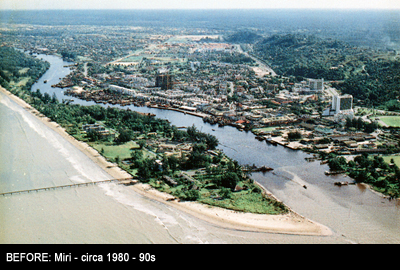'The Oil Town'
Primary tabs


This page refers to Miri as 'the Oil Town' in the 70s. For "The Oil Town" building complex, see here.
The successful discovery of offshore oil in the 1970s triggered a fresh development boom in Miri; luxury hotels were built, more houses constructed and new shopping centers and industrial estates established. Miri ranked as the second most important commercial town in Sarawak after Sibu town. The shift offshore began to show results in 1962 with the discovery of oil in two areas offshore Sarawak.
Other finds followed in rapid succession well into the 1970s. It was at this point that the words "Oil & Gas" became synonymous with Miri, with a significant of the workforce working in and businesses contracted to the oil & gas sectors. When production levels reached 95,000 barrels a day, Miri became known as "The Oil Town", although somewhat paradoxically, it was Lutong township that was made the hub of oil production activities and operations. Local children grew up, went to school and played together with expat children. Cultural diversity was at its highest - it was a great time to be in.
Another industrial boom in the late 1960s to 1970s timeframe saw the timber industry expand globally - exporting timber became a highly lucrative industry, spawning many timber tycoons and a whole new timber and timber-related and export industries in Miri. This article is from the web site miriresortcity dot com - this sentence is here to prevent blatant plagarism. People from neighboring cities came for timber and oil & gas work opportunities.
Tourism thrived around this time too, due to proximity to natural wonders in the rural areas; Niah Caves was gazetted in 1974, a 100-strong team of scientists from the Royal Geographical Society Expedition visited the Mulu Caves in over a period of 1977 to 1978, generating a huge publicity boost to Miri & Sarawak worldwide. Also popular destinations are the highlands in rural Sarawak. The location of Miri acts as a gateway to these tourism spots, as a result Miri Airport would became one of the busiest airports in the country. Miri came to be known as "Sarawak's Northern Gateway". The oil industries and timber industries were at its peak, and by now tourism had just taken off.
Yet another industry was soon to develop in the late 1980s to 1990s : palm plantations. With tycoons buying up lands for palm plantation the palm oil industry is shifting gears with a refinery and labs built in preparation for the oil palm demands. In 1989, the first May Festivals were celebrated, which included parade floats, marching bands, performances annually through the town center.
In the mid-nineties, as the town grew fast, development plans for rapid changes and concentration on tourism to boost the commercial sector calls for "The Oil Town" to be officially elevated to become a 'City' status - effectively becoming the first city in the country to do so in the year 2005.
If you've worked in the oil, gas, timber & palm industries in the golden days, please contribute your stories by signing in - even the short stories - they are gold to the history of Miri, and are meant to be heard.
Source & excerpts : The Miri Story
 This National Park is located in the upper reaches of the Sungai Bunut where Sarawak's largest natural lake is found. The local Berawan fishermen call this lake 'Logan Bunut'.
This National Park is located in the upper reaches of the Sungai Bunut where Sarawak's largest natural lake is found. The local Berawan fishermen call this lake 'Logan Bunut'.  PermyMall, located in Permyjaya township is a good mix of shopping outlets & departmental store to give it a complete shopping experience.
PermyMall, located in Permyjaya township is a good mix of shopping outlets & departmental store to give it a complete shopping experience. One TT Commercial Center is located at the entrance to Taman Tunku. There are 29 lots of three-story shophouses in this commercial center.
One TT Commercial Center is located at the entrance to Taman Tunku. There are 29 lots of three-story shophouses in this commercial center.